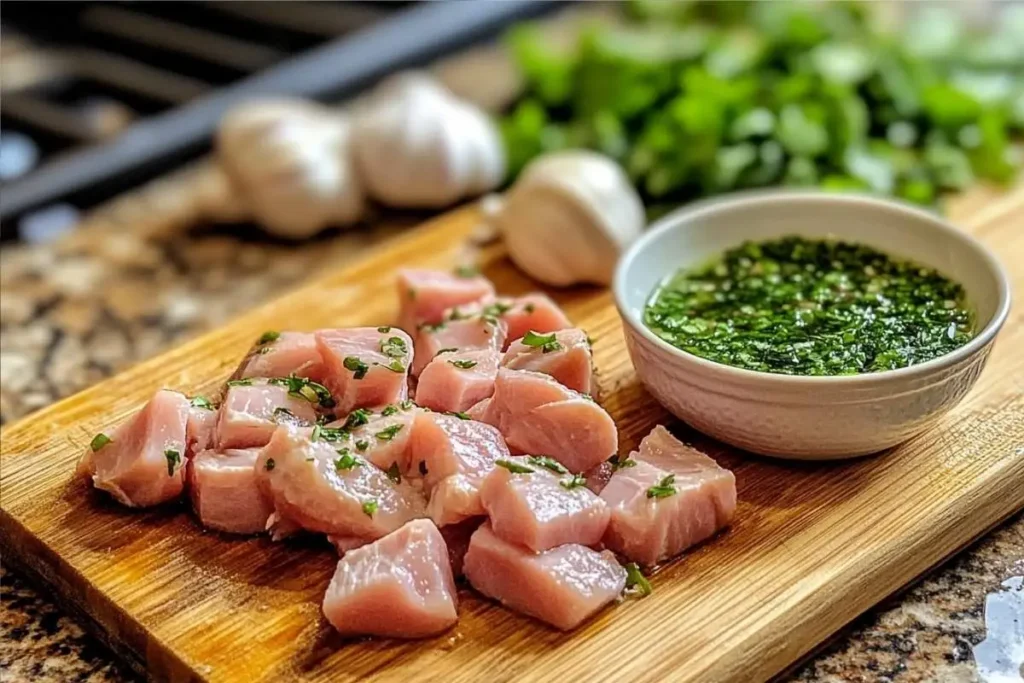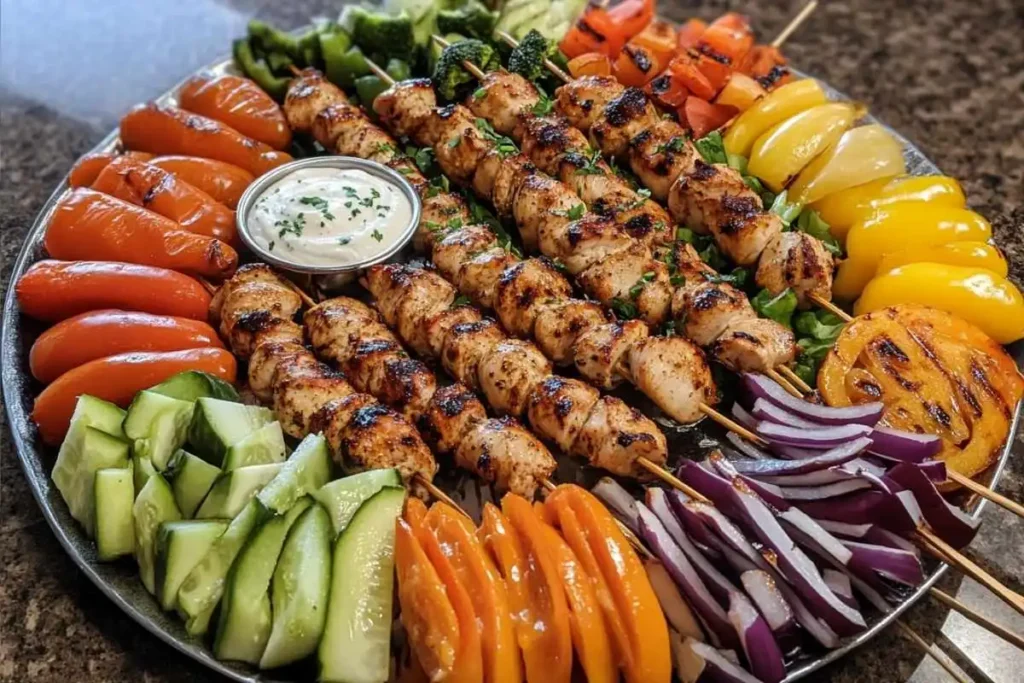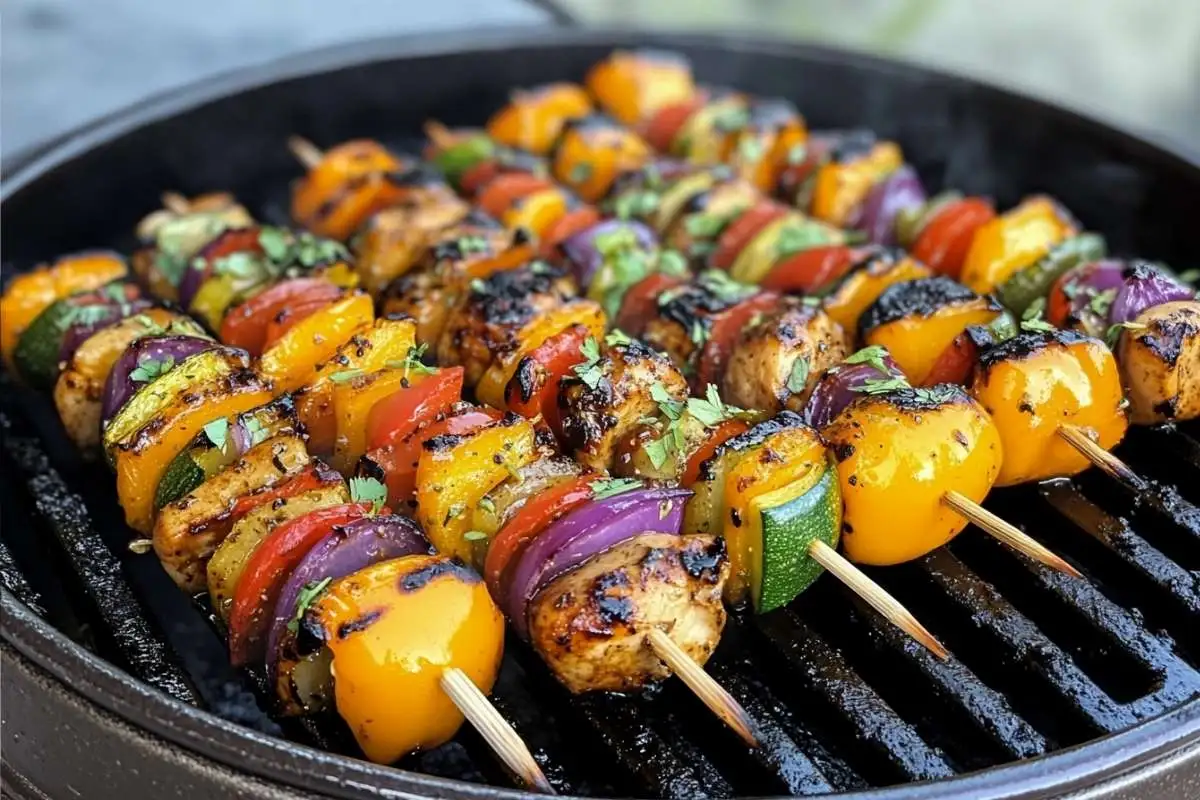Chicken skewers are a timeless favorite, blending juicy bites of protein with smoky, charred flavors that captivate taste buds worldwide. But here’s the kicker—choosing the right cut of chicken can make or break your skewers. Whether you’re grilling, baking, or air frying, the type of chicken you pick plays a significant role in flavor, texture, and overall success.
In this article, we’ll dive deep into the best cuts of chicken for skewers, explore factors to consider when choosing, and share pro tips to ensure your skewers are nothing short of perfect. By the end, you’ll know how to prepare skewers that are juicy, flavorful, and crowd-pleasing every single time.
Let’s get started with the essentials!
Introduction to Chicken Skewers
Why Choosing the Right Cut of Chicken Matters
Not all chicken cuts are created equal, especially when it comes to skewers. The goal is to create a balance between tenderness, flavor, and ease of cooking. Certain cuts excel because they stay juicy even under high heat, while others might dry out or lack flavor. Picking the wrong cut can lead to chewy, unappetizing skewers—nobody wants that!
But the right chicken cut? It can transform your skewers into something extraordinary. The secret lies in understanding how each cut behaves when grilled, baked, or air-fried. Cuts like thighs, breasts, or even drumsticks each have their pros and cons, making the selection process both an art and a science.
Overview of Chicken Skewer Versatility in Cooking
Chicken skewers are incredibly versatile, lending themselves to countless cuisines and cooking methods. They’re a staple at backyard barbecues, perfect for meal prep, and a favorite for weeknight dinners. Whether you’re layering them with colorful veggies or marinating them in exotic spices, chicken skewers adapt to almost any flavor profile.
From smoky grilled skewers to oven-roasted kebabs or crispy air fryer bites, the possibilities are endless. The best part? Once you master the perfect cut of chicken for skewers, you’ll have a go-to dish for any occasion.
Ready to discover which chicken cut will elevate your skewers? Let’s dive deeper!
Understanding Chicken Cuts for Skewers
Chicken Thighs: Juicy and Flavorful Option
Chicken thighs are often hailed as the gold standard for skewers, thanks to their rich flavor and natural juiciness. The higher fat content of thighs helps them stay moist, even when exposed to the intense heat of a grill or oven. Thighs are forgiving, making them ideal for novice cooks who want to avoid the risk of dry, overcooked chicken.
When marinated, the meat soaks up flavors beautifully, creating skewers that burst with taste in every bite. Whether you’re preparing Bang Bang Chicken Skewers or exploring bold spice blends like tandoori, thighs are a dependable choice for delicious results.
Chicken Breasts: A Lean Option for Skewers
For those seeking a leaner option, chicken breasts are a go-to. While they don’t have the same fat content as thighs, proper preparation can yield tender and juicy skewers. Marinating is key here—brining or soaking the chicken in a yogurt-based marinade can help retain moisture during cooking.
Breasts are also an excellent choice for those prioritizing a healthier meal. For instance, dishes like Blackened Chicken Alfredo benefit from the breast’s neutral flavor, allowing spices and sauces to shine without being overshadowed by the meat itself.
Drumsticks and Wings: Why They’re Less Common for Skewers
Drumsticks and wings, though flavorful, aren’t typically used for skewers due to their uneven shapes and bone structure. Skewers thrive on uniformity, ensuring even cooking. However, if you’re looking to experiment, deboning drumsticks can offer a more unique skewer experience.
Other Considerations: Organic vs. Conventional Cuts
When selecting chicken, considering the source can enhance both flavor and ethical satisfaction. Organic and free-range chicken often boast superior taste and texture. If you’re aiming for quality skewers, investing in high-grade chicken can make a noticeable difference.
Factors to Consider When Choosing Chicken Cuts
Texture and Moisture Content
The texture of the chicken determines its suitability for skewers. Cuts like thighs, with their inherent moisture, handle high heat gracefully, delivering tender results. On the other hand, lean cuts like breasts require more attention to prevent dryness. Using marinades and cooking at the correct temperature ensures the meat retains its moisture.
Cooking Methods: Grilling, Baking, or Air Frying
Your cooking method also influences the choice of chicken cut. Thighs excel on the grill, where their fat renders down to enhance flavor. Breasts perform well in air fryers or ovens, where controlled heat ensures even cooking. If you’re trying new techniques, recipes like Melt-In-Your-Mouth Chicken offer valuable insights into achieving tender results across methods.
Marination Tips for Perfect Skewers
Marination can elevate any chicken cut, but the type and duration vary. Thighs benefit from short marination times, while breasts often need a longer soak to infuse flavor and moisture. For skewers, using a marinade that includes fat, acid, and seasoning ensures your chicken shines in every bite.
Preparation Tips for Perfect Skewers
How to Cut Chicken for Even Cooking
When preparing skewers, how you cut your chicken makes a big difference. Uniform pieces ensure that everything cooks at the same rate, avoiding some chunks being overcooked while others are underdone. Aim for cubes about 1 to 1.5 inches thick—this size is perfect for quick, even cooking.
For chicken breasts, slice across the grain to maintain tenderness. Thighs are naturally more forgiving, but trimming any excess fat or connective tissue can enhance the texture. Remember, clean cuts lead to clean cooking!

Using Skewers: Wooden vs. Metal Options
Both wooden and metal skewers have their perks, but choosing the right type is essential. Wooden skewers are budget-friendly and disposable, but they need soaking in water for at least 30 minutes before use to prevent burning. Metal skewers, on the other hand, are reusable and conduct heat, which can help the chicken cook evenly from the inside.
If you’re grilling Bang Bang Chicken Skewers, soaking wooden skewers is non-negotiable. For air frying or baking, either type works beautifully. Pick what’s most convenient for your cooking style!
Marination Techniques for Maximum Flavor
A good marinade elevates chicken skewers from basic to brilliant. Include a balance of fat (like olive oil or yogurt), acid (such as lemon juice or vinegar), and seasoning (herbs, spices, or sauces). Let the chicken marinate for at least 30 minutes, but if you have time, overnight marination deepens the flavor.
For a fantastic marinade idea, consider the one used in our Melt-In-Your-Mouth Chicken Recipe, where ingredients create a juicy and flavorful outcome.
Popular Recipes and Flavor Pairings
Classic Marinades for Skewers
When it comes to skewers, a few classic marinades never fail. Teriyaki, lemon herb, and garlic yogurt are just a few examples that work wonders for both chicken thighs and breasts. These marinades not only enhance flavor but also keep the meat tender and juicy during cooking.

For a spicier twist, try the marinade featured in the Empress Chicken Recipe—its bold spices bring an irresistible heat perfect for grill nights.
Herbs and Spices to Enhance Chicken Flavor
The beauty of chicken skewers lies in their ability to absorb bold and fragrant spices. Paprika, cumin, garlic powder, and even a hint of cayenne can transform your skewers into a masterpiece. Fresh herbs like rosemary, thyme, or cilantro add another layer of complexity.
Serving Suggestions: Vegetables and Sides for Balance
Chicken skewers pair wonderfully with roasted veggies like zucchini, bell peppers, or cherry tomatoes. Layer these veggies between chicken chunks for added color and flavor. On the side, serve your skewers with fluffy jasmine rice or a crisp cucumber salad.
For inspiration, check out our Sweet Hawaiian Crockpot Chicken Recipe, which pairs savory chicken with tropical flavors, making it a delightful companion to skewer meals.
Common Mistakes to Avoid
Mistakes When Choosing the Best Chicken Cut for Skewers
Selecting the wrong chicken cut can lead to disappointing results. For instance, drumsticks and wings, though flavorful, are difficult to cook evenly on skewers due to their shape and bones. Chicken thighs, with their juicy texture, are often the best choice for skewers, while chicken breasts work well when marinated to prevent dryness.
Overcooking or Drying Out Chicken
One of the most common mistakes when preparing chicken skewers is overcooking the meat. This is especially true with chicken breasts, which can dry out quickly. To avoid this, keep a close eye on cooking times and always use a meat thermometer. The internal temperature of your chicken should reach 165°F (74°C) to ensure it’s cooked but still juicy.
If you’re unsure about timing, chicken thighs are more forgiving. Their higher fat content helps them stay moist even if they spend an extra minute or two on the grill. When choosing which cut of chicken is best for skewers, consider thighs for their flexibility and flavor.
Uneven Skewer Assembly
Another pitfall is uneven skewer assembly, where different-sized chicken pieces and vegetables lead to uneven cooking. Always cut your chicken and other ingredients into similar-sized pieces to ensure everything cooks at the same rate.
Stacking skewers too tightly can also cause undercooked centers. Leave a small gap between each piece to allow heat to circulate evenly.
Skipping the Marination Process
Neglecting to marinate your chicken is a missed opportunity for flavor. Marinades not only add taste but also help tenderize the meat. Even a simple mixture of olive oil, lemon juice, garlic, and herbs can work wonders. Skipping this step often leads to bland, uninspired skewers.
FAQs About Chicken Cuts for Skewers
What Part of the Chicken is Used for Skewers?
Chicken thighs and breasts are the most commonly used parts for skewers. Thighs are ideal for their juicy texture, while breasts are perfect for leaner, protein-packed meals. Both cuts adapt well to different marinades and cooking methods.
Should I Use Chicken Breast or Thigh for Skewers?
The choice between chicken breasts and thighs depends on your preferences. If you’re looking for rich flavor and tenderness, go for thighs. For a leaner option, breasts are the way to go. Either way, marinating is key to keeping the meat flavorful and moist.
What Cut of Meat is Best for Skewers?
Chicken thighs are widely regarded as the best cut for skewers because of their ability to retain moisture and absorb marinades. However, chicken breasts are also an excellent option when handled with care. For kebabs, even-sized cubes of either cut work perfectly.
Which Part of Chicken is Good for Kebab?
Both chicken thighs and breasts work well for kebabs. Thighs provide a juicier bite, while breasts offer a firmer texture. Combine them with vibrant veggies like peppers and onions for a balanced skewer.
Additional Tips for Perfect Skewers
Temperature and Cooking Time Recommendations
Cooking your chicken skewers to perfection requires precise temperature control. For grilling, preheat your grill to medium-high heat (around 375°F–400°F). This temperature is ideal for searing the outside while keeping the inside juicy.
In the oven, bake skewers at 400°F for about 20-25 minutes, flipping them halfway through. Air fryers typically require 375°F for 10-12 minutes, ensuring even cooking with a crispy finish. For grilling safety and best practices, check out the USDA’s Food Safety Fact Sheets.
Resting Chicken Before Serving
After removing the skewers from the heat, let them rest for 5 minutes. Resting allows the juices to redistribute within the meat, keeping it moist and flavorful. Skipping this step can lead to dry, less satisfying skewers.
Experimenting with New Skewer Ideas
Don’t be afraid to mix things up! Combine chicken with fruits like pineapple or peaches for a sweet contrast or explore global marinades like miso-ginger or peri-peri for bold flavors. No matter which cut of chicken is best for skewers, experimenting with ingredients can elevate your dish to a whole new level.
Conclusion and Final Thoughts
Choosing the right cut of chicken is the foundation of making exceptional skewers. While thighs are prized for their juiciness and rich flavor, chicken breasts offer a lean, versatile alternative. Whether you’re grilling, baking, or air frying, understanding how to prepare and cook each cut ensures success.
By following these tips and experimenting with marinades, veggies, and seasonings, you’ll master the art of creating mouthwatering chicken skewers. Ready to try something new? Check out our Bang Bang Chicken Skewers Recipe for a bold and exciting take on this classic dish.

